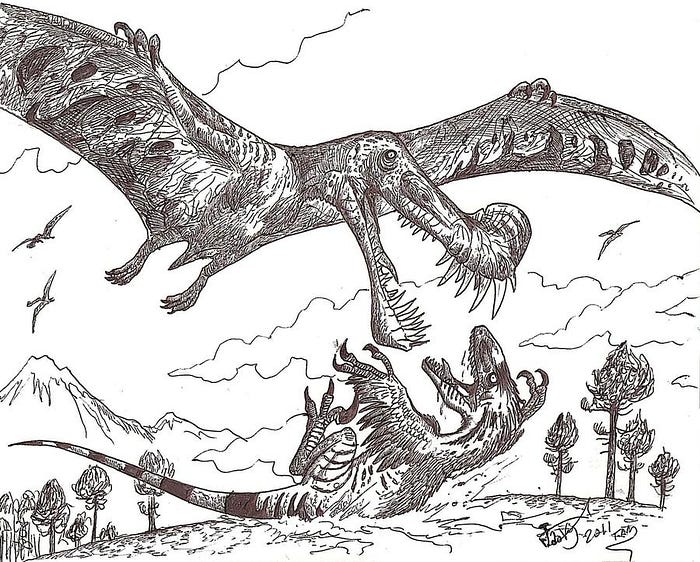The Mystery Of The Sky Dragons

“Coloborhynchus Attack” by HodariNundu.
In 2017 an abstract detailing isotope data on ornitocheiroid* pterosaurs was published. To my knowledge the full paper hasn’t been published yet, which is a shame given its base premise: that some ornithocheiroid pterosaurs might have preffered to hunt terrestrial prey.
*”Ornithocheiroid” here is used as it was conceived by Unwin 2003: any pterodactyloid pterosaur closer to Pteranodon longiceps than to Quetzalcoatlus northropi or Pterodactylus antiquus. The term was invented in Kellner 2003 to refer to a clade composed of Anhanguera blittersdorffi, Pteranodon longiceps, Dsungaripterus weii and Quetzalcoatlus northropi and from Andres 2008 onwards it has been redefined as including both Azhdarchoidea and Pteranodontia, the latter encompassing taxa as defined in Unwin 2003 due to the fact that traditional Pteranodontia (Nyctosauridae + Pteranodontidae) has been found paraphyletic in relation to these other taxa. There are a lot of reasons why this is stupid, most notably the fact that a traditional Pteranodontia is consistently being recovered again (Andres 2018, Longrich 2018), so Unwin 2003 definition it is. If you feel uncomfortable try mentally replacing “ornithocheiroid” with “pteranodontian” in your imagination.
Most ornithocheiroid pterosaurs are assumed to have been piscivores. Even with the “pterosaur revolution” of the 2010’s its pretty undeniable most species fit the traditional “seagull pterosaur” image: most are found in marine settings, most were soarers similar to modern pelagic birds like albatrosses and frigatebirds, several either have adaptations for launching out of water or ossified tendons indicating a perpetually aerial lifestyle and, most importantly, several taxa have been found with fish on their innards or pellets or conversely being eaten by marine predators (Witton 2013). However, quite a few taxa have been recovered in terrestrial settings, have lower aspect ratios and show adaptations for other lifestyles: in the case of istiodactylids for scavenging and in the case of boreopterids for trapping small freshwater prey (Witton 2013). If you assume lonchodectids are ornithocheiroids, then their purported azhdarchid-like morphology would make them an unique case of terrestrial foragers akin to modern storks and cranes (Witton 2013).

Istiodactylus latidens devouring a dead stegosaur by Mark Witton.
Still, the idea of raptorial ornithocheiroids has not been explored. Taxa usually identified as ornithocheirids and anhanguerids have large, forward facing eyes, large jaw muscles, “intimidating” teeth and distended palates, as opposed to the small eyes, cookie-cutter shark-like teeth (best suited to simply rip meat instead of killing prey) and non-distended palates of the scavenging istiodactylids and the small eyes, fragile teeth, weak jaw muscles and non-distended palates of the small-prey piscivore boreopterids (Witton 2013); these adaptations are serviceable for hunting aquatic prey, but they can also be translated to a terrestrial prey context, as seen in other groups. Furthermore, at least one taxa, “Anhanguera” robustus, had hindlimbs comparatively more specialised for terrestrial locomotion, indicating that, much like istiodactylids (Witton 2013) some ornithocheirids/anhanguerids could have walked more or less efficiently while still retaining a mostly aerial lifestyle (Naish 2018).
The presence of raptorial ornithocheiroids could explain a few quirks of pterosaur diversity throught time:
- Giant azhdarchids do not show up in the fossil reccord until the Late Cretaceous, after the extinction of toothed ornithocheiroids (Witton 2013). This could suggest that toothed ornithocheiroids occupied large volant predatory niches both on terrestrial and marine settings and were succeeded by large azhdarchids on the former and pteranodontians in the latter after the Turonian extinction event.
- The supposed absence of raptorial pterosaurs (which I’ve brought up several times when discussing flight in volaticothere mammals*) is thus addressed: they were there all along!
- The diversity of ornithocheiroids more or less parallels that of rhamphorhynchids, which similarly produced terrestrial carnivores and aquatic soarers (though rhamphorhynchid ecological diversity is somewhat more limited). As ornithocheiroids do not co-exist temporally with rhamphorhynchids (the only Jurassic putative representative, Archaeoistiodactylus linglongtaensis, has since turned out to be a basal monofenestratan [Wang 2014]), this leads credence to the idea that they evolved in the Early Cretaceous and are thus more closely related to azhdarchoids than ctenochasmatoids and other Jurassic pterodactyloids are.
- Given that pterosaurs are superprecocial and likely occupied several niches as they grew, this likely also solves the relative rarity of aerial insectivorous pterodactyloids, since the juveniles of these raptorial ornithocheiroids likely occupied such niches.
* Friendly reminder a paper on volaticotheres is coming out soon!
Hopefully more work on this topic is done on the near future.
References
https://gsa.confex.com/gsa/2017AM/webprogram/Paper305496.html
Kellner, A. W. A., (2003): Pterosaur phylogeny and comments on the evolutionary history of the group. pp. 105–137. — in Buffetaut, E. & Mazin, J.-M., (eds.): Evolution and Palaeobiology of Pterosaurs. Geological Society of London, Special Publications 217, London, 1–347
Unwin, D. M., (2003): On the phylogeny and evolutionary history of pterosaurs. pp. 139–190. — in Buffetaut, E. & Mazin, J.-M., (eds.): Evolution and Palaeobiology of Pterosaurs. Geological Society of London, Special Publications 217, London, 1–347
Andres, B.; Clark, J.; Xu, X. (2014). “The Earliest Pterodactyloid and the Origin of the Group”. Current Biology. 24: 1011–6. doi:10.1016/j.cub.2014.03.030. PMID 24768054.
Nicholas R. Longrich; David M. Martill; Brian Andres (2018). “Late Maastrichtian pterosaurs from North Africa and mass extinction of Pterosauria at the Cretaceous-Paleogene boundary”. PLOS Biology. 16 (3): e2001663. doi:10.1371/journal.pbio.2001663. PMC 5849296 Freely accessible. PMID 29534059
Witton, Mark (2013). Pterosaurs: Natural History, Evolution, Anatomy. Princeton University Press. ISBN 978–0691150611.
Martin-Silverstone, E., Sykes, D., Naish, D. (2018). “Does Postcranial Palaeoneurology Provide Insight into Pterosaur Behavior and Lifestyle? New Data from the Azhdarchoid Vectidraco and the Ornithocheirids Coloborhynchus and Anhanguera”. Palaeontology. doi:10.1111/pala.12390
Sullivan, C.; Wang, Y.; Hone, D.W.E.; Wang, Y.; Xu, X. & Zhang, F. (2014). “The vertebrates of the Jurassic Daohugou Biota of northeastern China”. Journal of Vertebrate Paleontology. 34 (2): 243–280. doi:10.1080/02724634.2013.787316.
